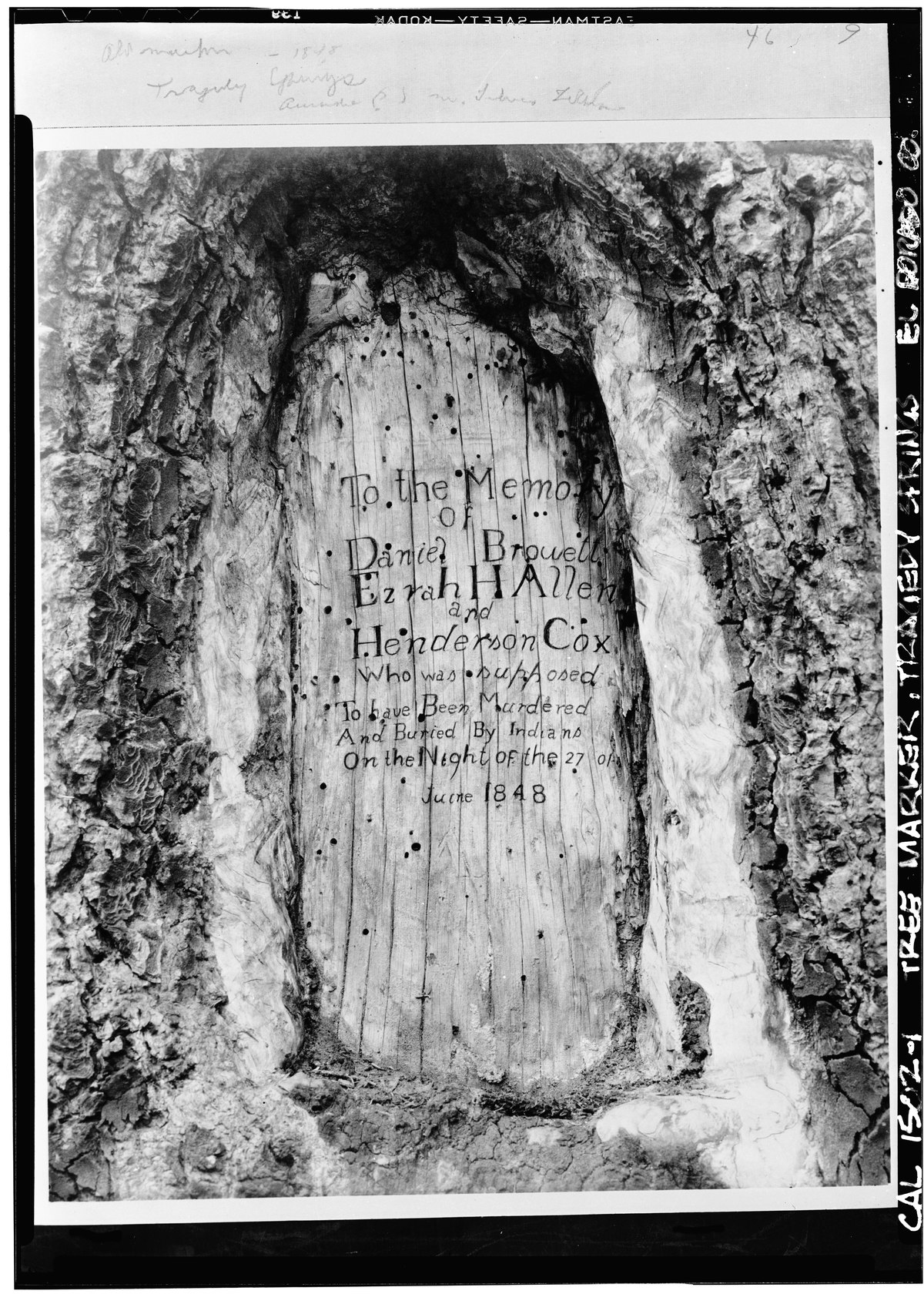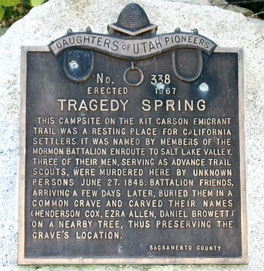Mormon Emigrant Trail
The Mormon Emigrant Trail has historic significance to both the Mormon Battalion and the 1849 California Gold Rush.
Brigham Young encouraged 541 men to enlist in the U.S. Army at the request of U.S. president Polk. The money they would earn would help fund their immigration to the Salt Lake Valley and would suggest to the Federal government that members of The Church of Jesus Christ of Latter-day Saints were loyal to their country. The Mormon Battalion was discharged from service on July 16, 1847. About 80 reenlisted in the Army. Some of those who did not reenlist traveled along the Sierra Nevada foothills to northern California. They spent the winter of 1847–1848 working in the Sutter’s Fort area and on April 9, 1848, they asked for wages so they could join the Saints. Sutter mostly paid in horses, livestock, wagons, and other supplies they would need for the trip to the Salt Lake Valley.
- The existing Old California Trail went from Sutter’s Fort north to Johnson’s Ranch (now Marysville) and then east to Emigrant Gap, Truckee Lake (now Donner Lake), along the Truckee River to present day Reno, Nevada. The snow was too deep and they were unable to make the trip over the Sierra Nevadas.
- It was decided that they would find a place of gathering and would assemble the group later to again try to leave. The California Trail had the disadvantage of requiring teams and wagons to cross the Truckee River some twenty-seven times and was very difficult, so the group decided they would try to find a better route when they were able to leave. June 17, 1848, Henry Bigler and two others set out to select a place of gathering. They found a place they called Pleasant Valley (still named that today) and June 21, 1848, the group began to assemble for their planned departure of the area.[1]
Daniel Browett, captain of the company, decided to ride out to scout a possible route. Ezra Allen and Henderson Cox joined him. By July 1, when the men had not returned, the company of about 45 men (and one woman, Melissa Coray) decided to press forward. By July 19, they reached an area they designated as Tragedy Spring because here they found the naked bodies of Browett, Allen, and Cox in a shallow, fresh grave.
- One of them had been hit in the face with an axe and shot in the eye. There were bloody broken arrows and bloody rocks in the brush around the site. They also found Allen’s double gold pouch with about $100 worth of gold in it. Allen always wore the pouch around his neck and it was felt that during the night attack and trying to rip the clothes off him, that it must have fallen, unnoticed, into the brush. The group . . . laid over another day to dig a deeper grave, build a rock cairn and carve a memorial plaque in a pine tree nearby. It had taken them 15 days to blaze the trail of 39 miles from Pleasant Valley.[2]
They marked the gravesite by engraving this inscription into a balsam fir tree: “To the memory of Daniel Browett, Ezrah H. Allen, and Henderson Cox, who were supposed to have been murdered and buried by Indians on the night of June 27, A.D., 1848. We call the place Tragedy Spring.”[3] The burial site became a Daughters of Utah Pioneers monument in 1967.[4] A portion of that trunk has been preserved as a memorial and is on display at the Marshall Gold Discovery Park at Coloma, California.
The group blazed the road ahead through snow sometimes up to 15 feet deep. “Henry Bigler reported he was scooping up snow with one hand, while picking wildflowers with the other.”[5]
- Saturday night of July, July 29th, found them camped at Red Lake, after descending the steep Carson Pass area. They traveled about 5 miles down Hope Valley on Sunday July 30th, which they had named because their journals said it was the first real sign of hope that they would get out of the mountains. The valley still called that today. They camped at Pass Creek, at the head of a 15-mile long canyon. It took them most of the week to cut the trail through some of the most difficult territory yet. The mountains rose several hundreds of feet on each side of the canyon. While they were working on this section, it snowed on them. They also had a group of 13 former Mormon Battalion members with pack animals ride into their camp. These riders had left the mines near Pleasant Valley and made the entire trip in 5 days over their new trail. . . .
- It had taken them over 30 days to blaze the trail of approximately 170 miles over the Sierras, that would become known as the “Mormon Carson Emigrant Trail.” It would be used the following few years by over 50,000 wagons and over 200,000 gold seekers, coming to the gold fields during the gold rush, which started in 1849. Traffic would be so heavy during the 90-day snow-free travel period, that according to some of the journals, it would be hours before there would be a break big enough between wagons to cross from one side of the trail to the other. The records for the summer of 1854, beginning July 1, 1854, show that even 5 years later, there were 800 wagons, 30,015 head of cattle, 1,903 horses/mules, and 8,550 sheep that came over the trail that season. [6]
This advance group of Battalion members reached the Salt Lake Valley on September 28, 1848. Ezra’s bag of gold was given to his widow, Sarah, making it possible for her and her two children to cross the plains to Utah.[7]
The Mormon Emigrant Trail, a stretch of road in the rugged Sierra Nevada mountain range, is now paved yet only passable for a short time each year. It was known as Iron Mountain Road until the 1980s. The paved Mormon Emigrant Trail still closes annually during the winter.
The Mormon Emigrant Trail was in the news in mid-August 2021 when the raging Caldor Fire engulfed the paved road.
- Also see Mormon Trail, which is the 1,300-mile (2,100 km) long route from Nauvoo, Illinois, to Salt Lake City, Utah, on which Mormon pioneers (members of The Church of Jesus Christ of Latter-day Saints) traveled from 1846 to 1848.

